
An intercontinental ballistic missile (ICBM) is a ballistic missile with a range greater than 5,500 kilometres (3,400 mi), primarily designed for nuclear weapons delivery. Conventional, chemical, and biological weapons can also be delivered with varying effectiveness, but have never been deployed on ICBMs. Most modern designs support multiple independently targetable reentry vehicle (MIRVs), allowing a single missile to carry several warheads, each of which can strike a different target. The United States, Russia, China, France, India, the United Kingdom, Israel, and North Korea are the only countries known to have operational ICBMs. Pakistan is the only nuclear-armed state that does not possess ICBMs.
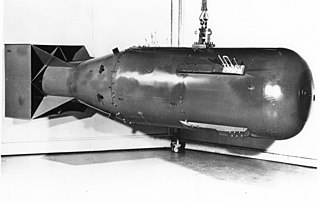
In nuclear strategy, a first strike or preemptive strike is a preemptive surprise attack employing overwhelming force. First strike capability is a country's ability to defeat another nuclear power by destroying its arsenal to the point where the attacking country can survive the weakened retaliation while the opposing side is left unable to continue war. The preferred methodology is to attack the opponent's strategic nuclear weapon facilities, command and control sites, and storage depots first. The strategy is called counterforce.

The LGM-30 Minuteman is an American land-based intercontinental ballistic missile (ICBM) in service with the Air Force Global Strike Command. As of 2024, the LGM-30G is the only land-based ICBM in service in the United States and represents the land leg of the U.S. nuclear triad, along with the Trident II submarine-launched ballistic missile (SLBM) and nuclear weapons carried by long-range strategic bombers.

Titan was a family of United States expendable rockets used between 1959 and 2005. The Titan I and Titan II were part of the US Air Force's intercontinental ballistic missile (ICBM) fleet until 1987. The space launch vehicle versions contributed the majority of the 368 Titan launches, including all the Project Gemini crewed flights of the mid-1960s. Titan vehicles were also used to lift US military payloads as well as civilian agency reconnaissance satellites and to send interplanetary scientific probes throughout the Solar System.
The SM-65 Atlas was the first operational intercontinental ballistic missile (ICBM) developed by the United States and the first member of the Atlas rocket family. It was built for the U.S. Air Force by the Convair Division of General Dynamics at an assembly plant located in Kearny Mesa, San Diego.

Damascus is a town in Faulkner and Van Buren counties of central Arkansas, United States. The population of Damascus was 382 at the 2010 census.
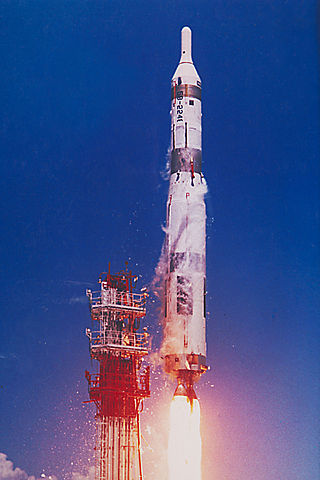
The Martin Marietta SM-68A/HGM-25A Titan I was the United States' first multistage intercontinental ballistic missile (ICBM), in use from 1959 until 1962. Though the SM-68A was operational for only three years, it spawned numerous follow-on models that were a part of the U.S. arsenal and space launch capability. The Titan I was unique among the Titan models in that it used liquid oxygen and RP-1 as propellants; all subsequent versions used storable propellants instead.

The LGM-118 Peacekeeper, originally known as the MX for "Missile, Experimental", was a MIRV-capable intercontinental ballistic missile (ICBM) produced and deployed by the United States from 1986 to 2005. The missile could carry up to eleven Mark 21 reentry vehicles, each armed with a 300-kiloton W87 warhead. Initial plans called for building and deploying 100 MX ICBMs, but budgetary concerns limited the final procurement; only 50 entered service. Disarmament treaties signed after the Peacekeeper's development led to its withdrawal from service in 2005.
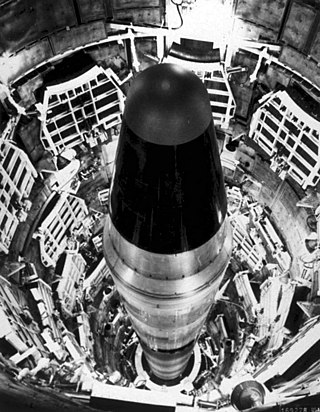
The Titan II was an intercontinental ballistic missile (ICBM) developed by the Glenn L. Martin Company from the earlier Titan I missile. Titan II was originally designed and used as an ICBM, but was later adapted as a medium-lift space launch vehicle to carry payloads to Earth orbit for the United States Air Force (USAF), National Aeronautics and Space Administration (NASA) and National Oceanic and Atmospheric Administration (NOAA). Those payloads included the USAF Defense Meteorological Satellite Program (DMSP), NOAA weather satellites, and NASA's Gemini crewed space capsules. The modified Titan II SLVs were launched from Vandenberg Air Force Base, California, up until 2003.
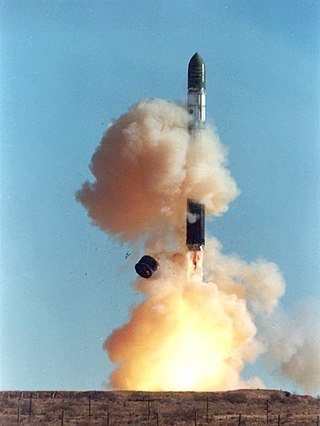
The R-36 is a family of intercontinental ballistic missiles (ICBMs) and space launch vehicles (Tsyklon) designed by the Soviet Union during the Cold War. The original R-36 was deployed under the GRAU index 8K67 and was given the NATO reporting name SS-9 Scarp. It was able to carry three warheads and was the first Soviet MRV missile. The later version, the R-36M, also known as RS20, was produced under the GRAU designations 15A14 and 15A18 and was given the NATO reporting name SS-18 Satan. This missile was viewed by certain United States analysts as giving the Soviet Union first strike advantage over the U.S., particularly because of its rapid silo-reload ability, very heavy throw weight and extremely large number of re-entry vehicles. Some versions of the R-36M were deployed with 10 warheads and up to 40 penetration aids and the missile's high throw-weight made it theoretically capable of carrying more warheads or penetration aids. Contemporary U.S. missiles, such as the Minuteman III, carried up to three warheads at most.
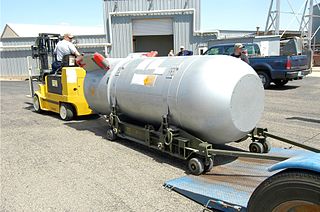
The Mk/B53 was a high-yield bunker buster thermonuclear weapon developed by the United States during the Cold War. Deployed on Strategic Air Command bombers, the B53, with a yield of 9 megatons, was the most powerful weapon in the U.S. nuclear arsenal after the last B41 nuclear bombs were retired in 1976.
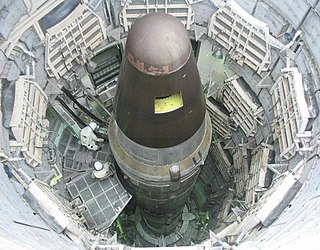
The Titan Missile Museum, also known as Air Force Facility Missile Site 8 or as Titan II ICBM Site 571-7, is a former ICBM site located about 40 km (25 mi) south of Tucson, Arizona in the United States. It was constructed in 1963 and deactivated in 1984. It is now a museum run by the nonprofit Arizona Aerospace Foundation and includes an inert Titan II missile in the silo, as well as the original launch facilities.
Dense Pack is a strategy for basing intercontinental ballistic missiles (ICBMs) for the purpose of maximizing their survivability in case of a surprise nuclear first strike on their silos conducted by a hostile foreign power. The strategy was developed under the Reagan administration as a means of safeguarding America's inventory of MX missiles during the final decade of the Cold War. It was never used; MX was deployed in existing silos and then removed from service as the Cold War ended.
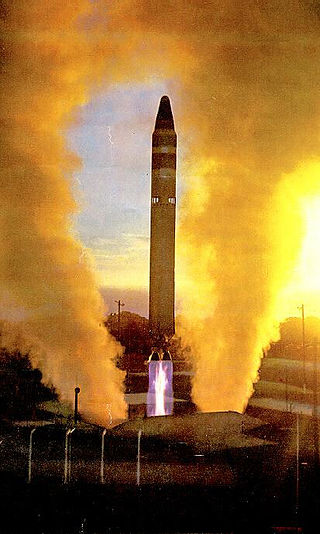
The 373d Strategic Missile Squadron is an inactive United States Air Force unit that was last assigned to the 308th Strategic Missile Wing at Little Rock Air Force Base, Arkansas. The 373rd was equipped with the LGM-25C Titan II Intercontinental ballistic missile in 1962, with a mission of nuclear deterrence. The squadron was inactivated for the last time as part of the phaseout of the Titan II ICBM on 18 August 1987.

The 374th Strategic Missile Squadron is an inactive United States Air Force unit, last assigned to the 308th Strategic Missile Wing at Little Rock Air Force Base, Arkansas. The squadron was equipped with the LGM-25C Titan II intercontinental ballistic missile (ICBM), with a mission of nuclear deterrence. It was inactivated as part of the phaseout of the Titan II ICBM on 15 August 1986. The squadron was responsible for Launch Complex 374–7, site of the 1980 explosion of a Titan II ICBM in Damascus, Arkansas.

A missile launch facility, also known as an underground missile silo, launch facility (LF), or nuclear silo, is a vertical cylindrical structure constructed underground, for the storage and launching of intercontinental ballistic missiles (ICBMs), intermediate-range ballistic missiles (IRBMs), medium-range ballistic missiles (MRBMs). Similar facilities can be used for anti-ballistic missiles (ABMs).

The Damascus Titan missile explosion was a 1980 U.S. nuclear weapons incident involving a Titan II Intercontinental Ballistic Missile (ICBM). The incident occurred on September 18–19, 1980, at Missile Complex 374-7 in rural Arkansas when a U.S. Air Force LGM-25C Titan II ICBM loaded with a 9-megaton W-53 nuclear warhead experienced a liquid fuel explosion inside its silo.
Swarmjet was an extremely short-range single-shot anti-ballistic missile (ABM) system proposed by the United States as a defensive measure during the development of the MX missile. It consisted of a launcher containing thousands of spin-stabilized unguided rockets that would be fired into the path of an enemy nuclear warhead, enough that it would be highly likely one of the rockets would hit the warhead and destroy it.













